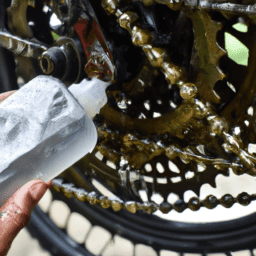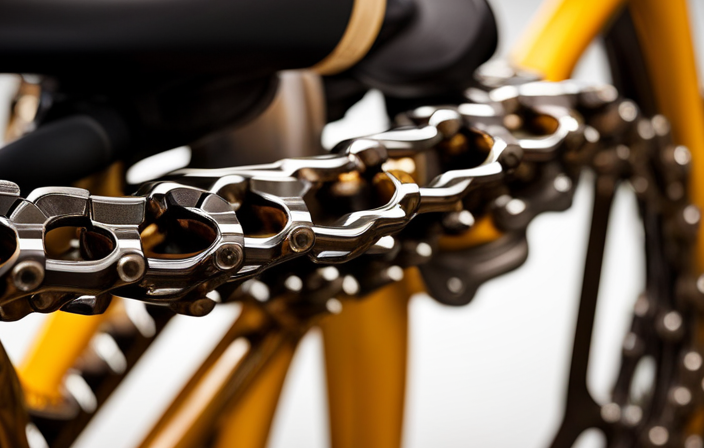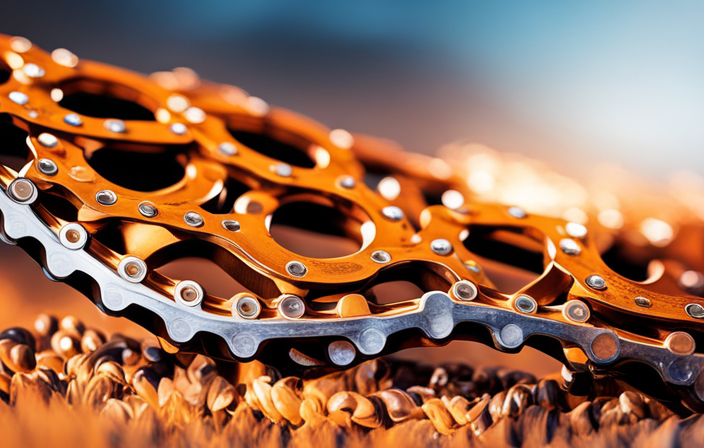Hello fellow bike enthusiasts, today I’m excited to discuss with you some advice on correctly applying lubricant to your bike chain. Keeping your chain lubricated is among the most crucial upkeep activities you can undertake, since it aids in minimizing wear and tear, prolongs the life of the chain, and guarantees seamless shifting between gears.
Before we dive into the details, let me first tell you what you’ll need. You’ll need a quality bicycle lubricant, a clean rag, and some gloves to protect your hands. It’s important to use a dedicated bike lubricant as other products like WD-40 or motor oil can damage your bike’s components.
Now that you have your tools and materials, let’s get started.
Key Takeaways
- Choose an appropriate lubricant based on your riding style and weather conditions.
- Clean your bike thoroughly before applying lubricant, paying special attention to the chain, chainrings, and cassette.
- Apply lubricant evenly and cover the entire length of the chain, but be careful not to over-lubricate.
- Check for excess lubricant and wipe away any visible drips or pooling to ensure proper lubrication.
Gather Your Tools and Materials
You’ll need a few things to get started, so grab your rag, lubricant, and chain cleaning tool. A dedicated chain cleaning tool is highly recommended as it makes the cleaning process easier and more effective. There are many lubricant types to choose from, including wet, dry, ceramic, and wax-based. It’s important to select a lubricant that’s appropriate for your riding conditions and the type of chain on your bike.
Once you have your tools and materials ready, it’s time to prepare your bike for the lubing process.
Prepare Your Bike
Before applying the lubricant, make sure your bike is clean and free of any dirt or grime that may have accumulated on its moving parts. Start by cleaning your bike with a soft-bristled brush and mild soap. Pay special attention to the chain, chainrings, and cassette.
Once you’ve rinsed off the soap, dry your bike thoroughly with a soft towel. After your bike is clean, inspect the parts for wear and tear. Check the chain for any rust, stiff links, or excess slack. Inspect the chainrings and cassette for any broken teeth or signs of wear.
Once you’ve determined that your bike is in good condition, choose an appropriate lubricant that matches your riding style and the weather conditions. With your bike clean and prepped, you can now move on to applying the lubricant to the chain.
Apply Lubricant to the Chain
Now that your bike is clean and in good condition, it’s time to give your chain the attention it deserves by applying some lubricant. Before we get into the actual process, it’s important to understand the types of lubricants available in the market. There are two main types: wet and dry lubricants. Wet lubricants are oil-based and are best used in wet and muddy conditions, while dry lubricants are wax-based and are best used in dry and dusty conditions. It’s important to use the appropriate lubricant for the conditions you will be riding in.
Once you have chosen the appropriate lubricant, it’s time to apply it to the chain. Start by applying the lubricant to the inside of the chain while slowly rotating the pedals backwards. Make sure you apply the lubricant evenly and cover the entire length of the chain. After the first application, let the lubricant sit for a few minutes before wiping off any excess lubricant with a clean cloth. It’s important to not over-lubricate the chain as this can attract dirt and debris which can wear out the chain faster. The frequency of application will vary depending on the conditions you ride in, but a general rule of thumb is to lubricate the chain every 100-150 miles.
After wiping off excess lubricant, it’s time to move on to the next step of the process: wiping off excess lubricant.
Wipe off Excess Lubricant
Now that I’ve applied lubricant to the chain, it’s important to wipe off any excess.
I use a clean rag to gently wipe the chain, making sure to remove any excess lubricant that can attract dirt and grime.
Checking for excess lubricant is crucial to ensure that the chain is properly lubricated and not over-lubricated, which can cause more harm than good.
Use a Clean Rag to Wipe the Chain
With a gentle touch, give the chain a wipe-down using a fresh rag to remove any grime or debris. This step is important in ensuring that the lubricant will be able to penetrate the chain’s links and rollers, as any excess dirt and debris may hinder the lubricant’s effectiveness.
Chain cleaning is an essential part of chain maintenance techniques, and this simple wipe-down should not be overlooked. When wiping the chain, make sure to cover every link and roller. Use a clean rag to avoid introducing any additional dirt onto the chain. It’s also important to be gentle when wiping the chain to avoid damaging it.
Once you have wiped the chain, move on to the next step of checking for excess lubricant to ensure that your chain is in optimal condition for your next ride.
Check for Excess Lubricant
After wiping the chain clean, it’s important to inspect it for any excess lubrication that may have accumulated. Here are some steps I take to remove buildup and avoid over lubrication:
-
Look for any visible drips or pooling of lubricant on the chain. This can attract dirt and grime, leading to a gritty and noisy chain.
-
Use a clean rag to gently wipe away any excess lubricant. Be sure to get into the crevices of the chain where lubricant can accumulate.
-
Spin the pedals backwards to check if there is still any excess lubrication. If you see any flinging off the chain, wipe it away with the rag.
-
Avoid over lubrication by applying just enough to cover the chain. Too much lubricant can attract dirt and grime, cause the chain to slip, and require more frequent cleaning.
-
Repeat this process regularly to ensure your chain stays clean and properly lubricated.
Now that the chain’s clean and lubricated, it’s important to keep up with regular maintenance to prolong the life of the chain.
Maintenance Tips
To keep your bike running smoothly, you should regularly maintain it by cleaning and lubricating the chain. While lubricating the chain is important, it is equally important to use the proper frequency and types of lubricants. This will ensure that your chain stays in good condition and that your bike runs efficiently.
When it comes to frequency, it is recommended that you lubricate your chain every 100-150 miles or every 5-7 rides. This will vary depending on weather conditions and how often you ride. As for the type of lubricant, there are several options to choose from such as wet, dry, and ceramic. Wet lubricant is best for wet and muddy conditions, while dry lubricant is best for dry and dusty conditions. Ceramic lubricant is ideal for high-performance bikes and provides long-lasting lubrication. By choosing the right lubricant and following the recommended frequency, you can extend the life of your chain and improve the performance of your bike.
| Type of Lubricant | Best Conditions | Pros | Cons |
|---|---|---|---|
| Wet | Wet and muddy | Stays on chain longer, provides better protection | Attracts dirt and grime, requires more frequent cleaning |
| Dry | Dry and dusty | Doesn’t attract dirt, requires less frequent cleaning | Doesn’t last as long as wet lubricant |
| Ceramic | High-performance bikes | Long-lasting lubrication, reduces friction | More expensive than other types of lubricants |
Remember to always clean your chain before applying lubricant and wipe off any excess. This will prevent excess build-up and ensure that your chain runs smoothly. By following these maintenance tips, you can keep your bike in top condition and enjoy a smoother ride.
Frequently Asked Questions
How often should I lubricate my bike chain?
I lubricate my bike chain every 100-150 miles. Regular lubrication prevents rust and corrosion, reduces friction, and extends the life of the chain. Over lubrication attracts dirt and grime, causing excess wear and a noisy ride.
Can I use any type of lubricant on my bike chain?
When it comes to lubricating your bike chain, it’s important to consider compatibility concerns. Not all lubricants are suitable for all types of chains. I recommend using a high-quality chain lubricant that is specifically designed for your bike’s chain.
Is it necessary to clean my bike chain before lubricating it?
Skipping chain cleaning can decrease the lifespan of your bike chain by up to 50%. While there are chain cleaning alternatives, cleaning it beforehand ensures better lubrication and prevents dirt buildup.
How do I know if I’ve applied enough lubricant to my bike chain?
To avoid over lubrication, I check that the chain tension is correct before applying. Signs of over lubrication include a build-up of excess oil and a chain that attracts dirt and grime.
Can I use WD-40 to lubricate my bike chain?
I wouldn’t recommend using WD-40 as a bike chain lubricant as it’s not designed for that purpose. Alternative lubricants such as chain-specific oils or waxes are better options. Proper application technique involves cleaning the chain first and applying the lubricant evenly.
Conclusion
In conclusion, lubing your bicycle chain is an essential maintenance task that every cyclist should be familiar with. It doesn’t matter whether you’re a seasoned rider or just starting out, knowing how to properly lubricate your chain can help prolong its life and improve your overall cycling experience.
While it may seem like a daunting task at first, with the right tools and knowledge, lubing your chain can be a simple and straightforward process. By taking the time to properly prepare your bike, applying the correct amount of lubricant, and wiping off any excess, you can ensure that your chain is running smoothly and efficiently.
But don’t stop there – regular maintenance is key to keeping your chain in top shape. Regularly cleaning and lubricating your chain, as well as checking for wear and tear, can help prevent costly repairs down the line.
So, take the time to learn how to properly lube your chain, and enjoy a smoother, more enjoyable ride.









